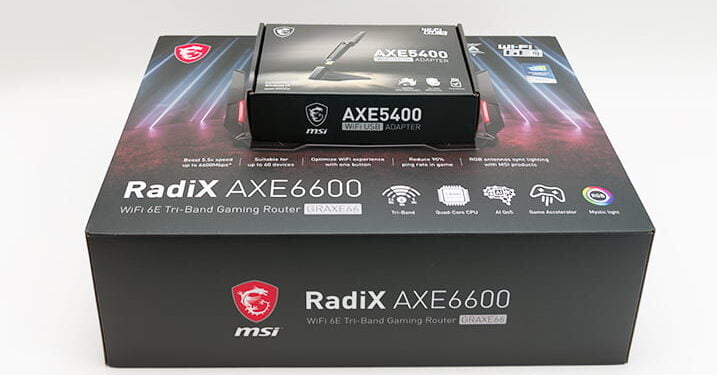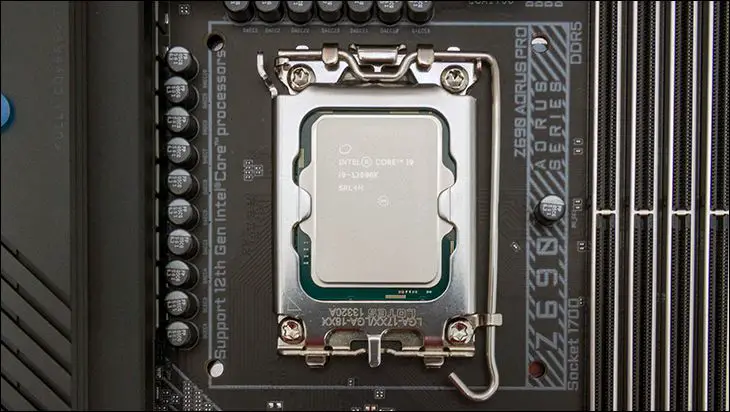
Turing our attention to the star of this combo we come to the somewhat portable MSI AXE5400 WiFi USB Adapter. We say this is the star as it is built upon a new breed of WiFi adapters that combine ease of use, ease of setup, and rather decent performance. To be precise, this MSI branded adapter makes use of one our recent favorite hardware options: EdiMAX based Realtek RTL8832CU option. That however is getting ahead of ourselves, so let’s backup a bit and take this one step at a time.
The shipping container MSI is using is top notch. A big on the big side for what it is but the combination of good looks with a veritable ton of information is a winning one.
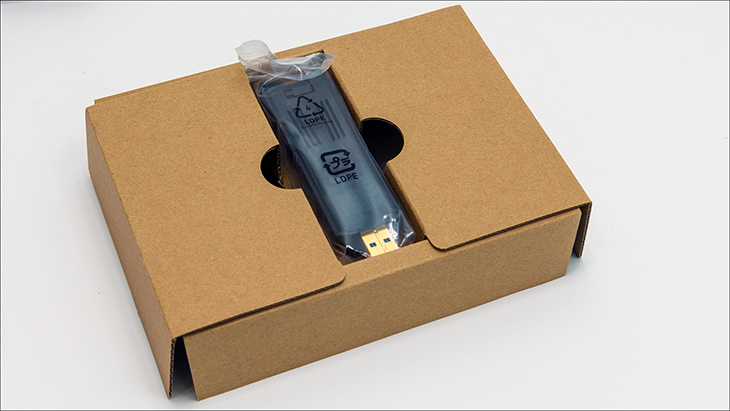
Furthermore, all that room allows MSI the luxury of using a lot of internal protection. Taking the form of carboard with multiple crumple zones, this is a box that can survive a lot of trauma. So much so that we wish MSI had asked, and been given, a ESD baggie to house the AXE5400 USB adapter… instead of standard plastic. That would have allowed this option to boast blunt, cutting, and magnetic force protection. But considering the nature of the device, ESD is pretty much a non-issue to start with and we can give it a pass.
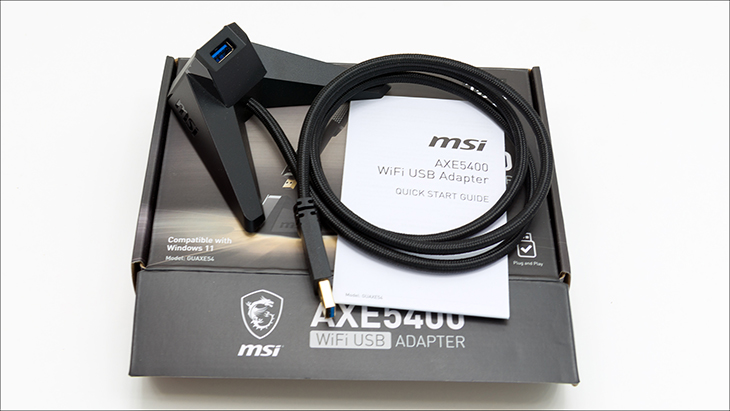
The accessories for this device are impressive. With that said, if you have not dealt with the latest and greatest adapters it may be a bit puzzling. We say this as MSI has knocked it out of the park with the included desktop adapter (or what they call a ‘cradle’). With most USB single port ‘adapters’ the USB 3.0 Type-A port is installed ‘straight up’ in the 90-degree orientated. This is a terrible design choice, but it does allow the OEM/ODM to make a smaller foot-print adapter to satisfy their contract obligations. Sadly, merely meeting their obligations usually results in a tall(er) final build that is rather ‘tippy’ and prone to being easily knocked over.

MSI on the other hand has opted for a wide V shape base that certainly shares a lot of DNA with their latest motherboard’s stock WiFi 6E antenna array. Put bluntly, it is a highly stable platform for their AXE5400 adapter. Though to be fair we also like it because MSI has angled the port rearwards by 30 degrees (i.e. it is in the 60-degree orientation not 90). Which means that you can turn the base and the external antenna array to actually get a stronger, clearer connection… especially if your Access Point is on your ceiling and not the wall. Dollop in a ~1 meter long, tightly braided, USB cable and it is obvious that MSI put thought into what they wanted EdiMAX to build.
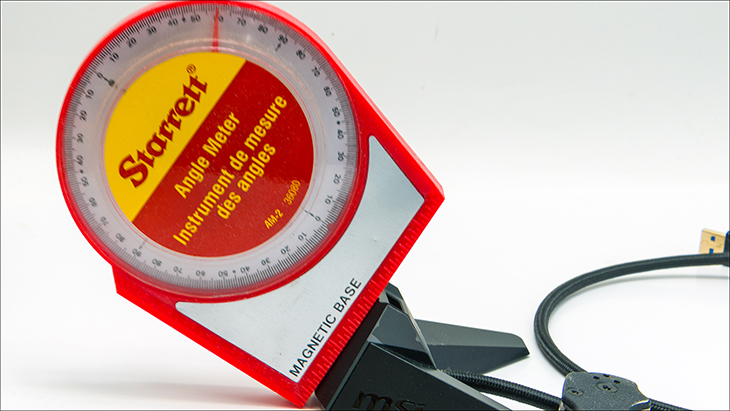
So no the cradle may be unusual but we doubt it will confuse many. Instead, what will probably confuse people is the fact that there is no installation driver disc in the box. Some may assume that means you need to download the driver package before you can use this bad-boy… and thus create a catch 22 of needing a working connection to get your WiFi up and running. This is wrong. Yes. In previous generations, and iterations of the underlying design, that is basically what you would have to do. EdiMAX helped to change the game with this latest gen of USB adapters via the inclusion of a small 128MB NOR flash storage chip on the PCB.
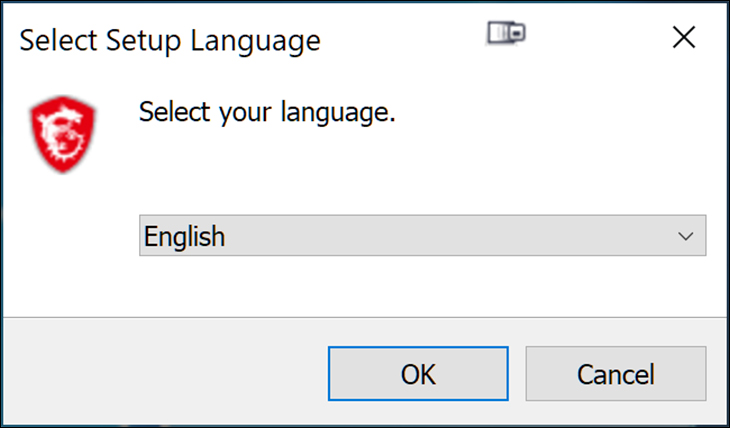
While it is true that NOR is a type of Flash Memory based storage it is eons more stable than NAND (aka the storage inside your SSD, USB flash drive, etc. etc.). So to get this adapter up and running all one need do is plug the AXE5400 into a free USB port (or the adapter first and then the AXE5400 into its custom ‘cradle’)… and click next on the incoming popup. Bang. Done. No fuss. No muss. It is why MSI opted for them and why they have quietly been ODM’ing for major brands for many, many years now.

Moving on. The one downside to WiFi 6E USB based adapters, especially external antenna array models, is the fact that they are big. Very big. They are so big they remind us of old school USB 2.0 ‘high capacity’ flash drives from the Y2K era. They probably will not fit easily in your pocket (unless you carry a massive phablet instead of a phone). They do however fit in a briefcase, a book bag, and a tool bag. So while big they are not that big. The reason for their enhanced size is because they are tri-band WiFi adapters, with a 2×2 antenna array, that use (relatively) high performance WiFi ‘controller’ processors.
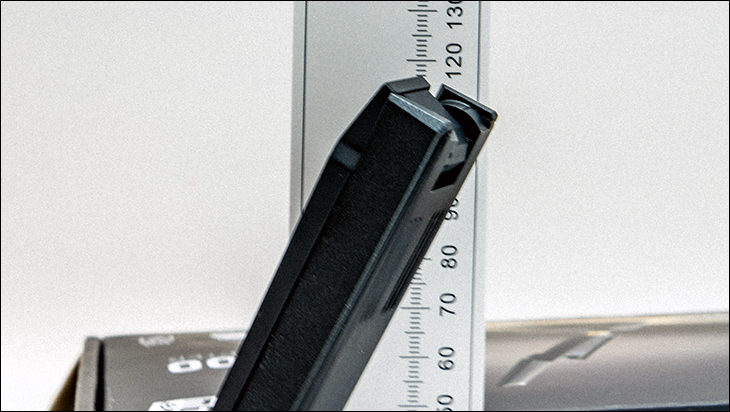
This is why you should not be surprised to see the AXE5400 topping out at about 120mm height when in its cradle… and the antenna array in the ‘closed’ (or ‘transportation’) orientation.
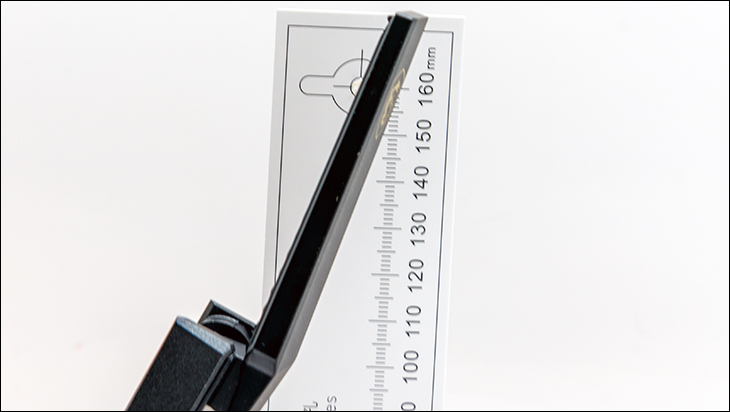
When full extended the AXE5400 is about 175mm tall. Which is pretty close to what a modern motherboard’s default external antenna array sits at. So, for mainly desktop users this height in a nothing burger. Nor is the aggressive lines and overall shape going to standout on the typical modern PC system… as this really does look more like the antenna array for a PCIe WiFi adapter rather than an oversized USB WiFi device.
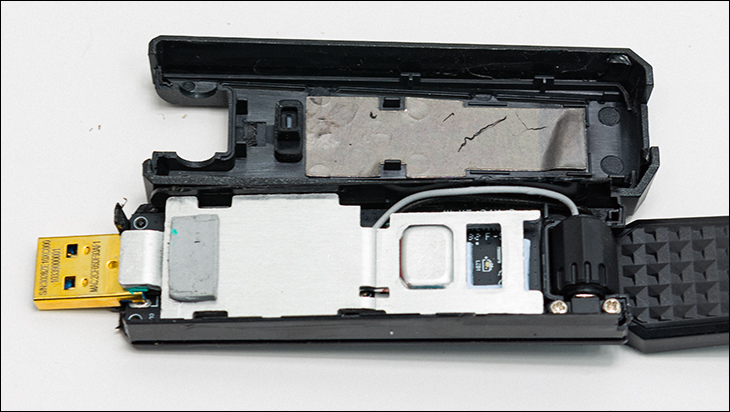
We do not recommend shucking your AXE5400 but if you do, you will be greeted to multiple important components housed inside the plastic chassis. The first is the pair of (actually good) AirGain 2.4/5/6Ghz range antennas. This actually is one the critical parts that separate the cheap Chinesium/AliExpress EdiMAX built USB adapters from the good EdiMAX built units… as these two antennas cost more than some of those “AliE Specials”. In a nutshell AirGain know how to build very good, yet compact antennas. More importantly they can do so that are good for a wide range of frequencies. Yes. In a perfect world we would see six antennas. With a pair optimized (1/4 to 1/2 wavelength) to each of radio spectrums used by WiFi. Good Luck with that as we are not in Perfect World Universe. We are ClownWorld Universe where the best we can hope for is ‘Good Enough’. So while they are not perfectly optimized for each band they are better than ‘good enough’ at covering 4.2cm to 12.5cm radio waves… though based on the fact that are part of the ‘E’ series they will do a bit better at the smaller end rather than the larger 2.4GHz end. As they should… as 2.4GHz is slow compared to the new 6GHz band. Thus, people do not expect all that much from 2.4GHz connections these days.

Moving on. The next important feature is the heatsink. As you can see it is a full coverage chunk of alloy that weighs about 10 grams… or nearly 22% of the weight of this adapter (officially 46 grams sans cradle). Much like the antennas are what separate cheap junk from good value USB adapters the heatsink (especially on WiFi gen 6 and up models) and the heat pads used are important. We have dissembled some units where the sink was pretty much made from bottlecaps and the pads were basically thick foam tape… and was about as effective at cooling the chipset as you would expect. Thus, once again MSI knew to specify and get EdiMAX’s A game and not accept their default… ‘value’ options.

As we mentioned previously this bad boy comes with a NOR flash memory chip. To be precise it is a top notch WinBond “SpiFLASH” W25Q128JVSIQ 128MB Not-Or flash memory IC. A chip which actually costs only about $1.50 USD at the tray purchase level. Once again proving that the cost of something does not always translate into the usefulness of said item. Afterall, that is a rounding error in a device’s build out cost and yet transforms a decent design into an incredibly useful and user-friendly one.

Moving on. This is a RealTek RTL8832CU chipset based unit. There is not much to say about it as its RealTek and the best we can say about their networking designs is… they make very decent audio CODECs. On the plus side, the new ‘C’ version is pretty decent. Which is about right for Realtek taking 3 tries / generations to get a design ‘right(ish)’ and probably about 4 gens away from being great (which if Realtek holds true to form is probably about 2 more than they will spend the RnD effort on before going back to a new shiny gen 1 design). So while we would never, ever trust Realtek in a business (let alone Enterprise) environment… for the home user it is pretty peppy and powerful. More importantly it is rather frugal when it comes to power consumption and thus heat output.
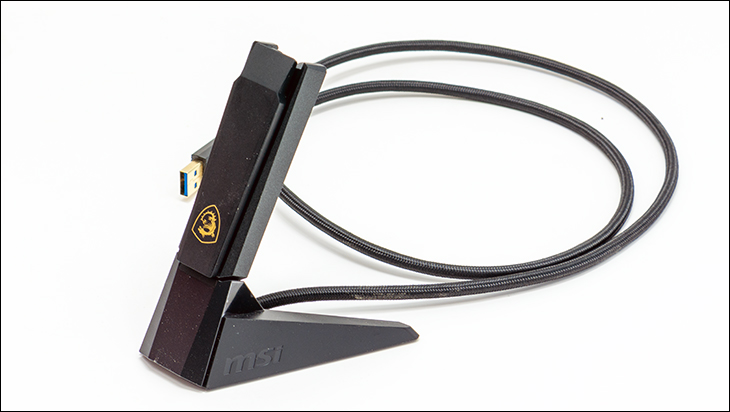
Sadly, the 32 variant does not include BlueTooth 5.3 abilities. In typical RealTek fashion, they specifically made two models and it is the noticeably more expensive 52CE variant that offers such ‘advanced’ features like BT5.3. Yes. This does mean MSI should have spent the couple extra dollars to make the AXE5400 a more well-rounded device, but much like the Radix router it would have pushed the asking price out of the realm of value and back into the sea of sameness that drowns so many models each and every year. Afterall EdiMAX would have been happy to modify their default design’s hardware while they were modding the exterior shell for MSI, they would have just charged a lot for it – with ‘Cost Plus’ being to the phrase of the day during contract negotiation. Especially when they probably would have demanded also swapping out the 128MB for a (~3.50 USD) 256MB Windbond IC. Which in turn would have transformed a ~60USD adapter in a $75 dollar one.

Overall, and much like the Radix router, the USB based AXE5400 is a well-executed, proven design. One that combines ease of use, ease of installation… and above all easy on the pocketbook asking price. It just may shock some buyers who have not purchased a… proper sized WiFi adapter since the WiFi 5 days. Color us impressed.
